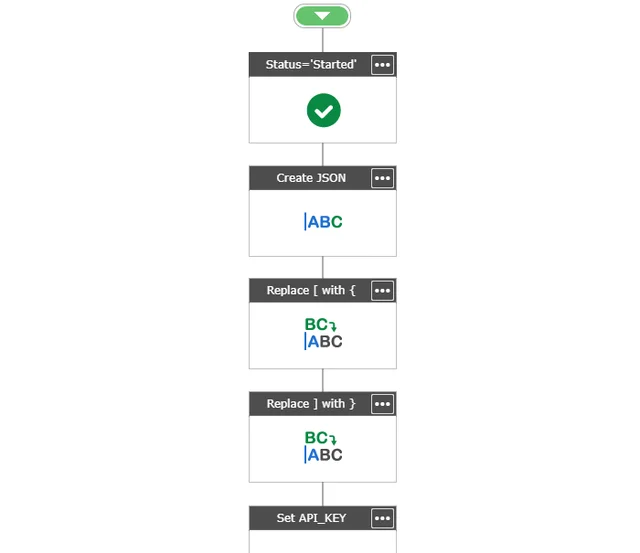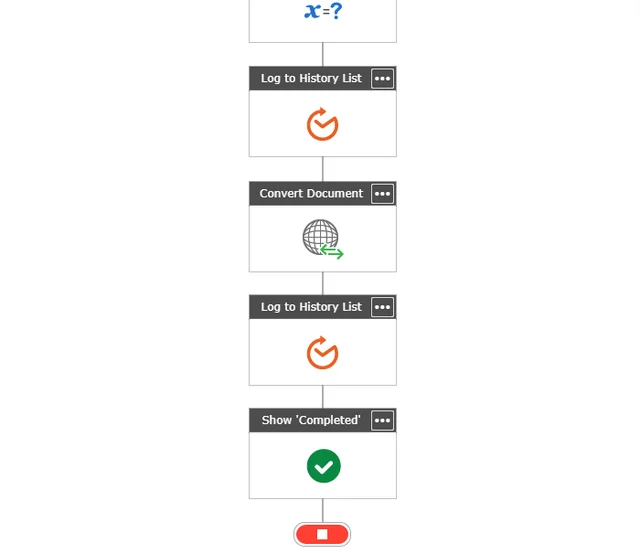We recently released the Muhimbi PDF Converter Xtension for Nintex Automation Cloud. You can download it here or learn more about available Muhimbi deployments for Nintex on our product page.
We’ve been working with Nintex Workflow ever since we integrated it into PDF Converter for SharePoint On-Premises.
One of the workarounds we’ve recommended to our customers over the years is to create an MS SharePoint Designer workflow using our workflow actions and invoke that from Nintex Workflow for Microsoft 365. However, this doesn’t leverage the full power of Nintex Workflow for Microsoft 365 and Muhimbi PDF Converter for SharePoint Online.
One other way to leverage the full power of Nintex Workflow for Microsoft 365 and Muhimbi PDF Converter for SharePoint Online is to integrate the functionality exposed by PDF Converter for SharePoint Online directly into a Nintex workflow by invoking our comprehensive REST API.
When we first released Muhimbi PDF Converter for SharePoint Online in early 2015, we were very much aware that, due to technical limitations in MS SharePoint Online, it wouldn’t be possible to bring the full power of our existing on-premises (SP2007–SE) products to the cloud. The first release focused on the most important elements, but one of the key features of our on-premises products was missing: an API to allow integration with third-party solutions and software partners.
Although we have a comprehensive Web Services (SOAP) interface exposed by our on-premises products, it’s less suitable for use by online subscription-based services. So, we now have a simplified REST-based interface, as that’s how modern systems, especially Cloud-based products, talk to each other. This new REST-based service was launched as part of the PDF Converter Services product. This is a separate product that has no dependencies on MS SharePoint and can be used to integrate with services such as Microsoft Power Automate, Azure Logic Apps, C#, Java, PHP, JavaScript, Python, and Ruby, as well as many other services, including Nintex Workflow for Microsoft 365. Although it’s available as a standalone subscription, this new service is automatically included in each PDF Converter for SharePoint Online subscription at no additional charge.
Using Nintex Workflow to Convert Scans and Images to PDF
These next sections will walk you through how to use Nintex Workflow to convert scans and images to PDF documents.
Prerequisites
Ensure the following prerequisites are in place:
- Muhimbi PDF Converter for SharePoint Online installed and enabled in your workflow’s site with a full or trial subscription.
- A PDF Converter Services full or trial subscription and an associated API key (start trial).
- Nintex Workflow for Microsoft 365 installed and enabled in your workflow’s site.
- The appropriate privileges to deploy these apps, as well as author workflows.
- Working knowledge of Nintex Workflow for Microsoft 365.
Note that this article is for the MS SharePoint Online version of Nintex Workflow.
Building the Workflow
It’s strongly recommended to follow the tutorial below, but the workflow is available for download as well. To use the download, import the file in Nintex Workflow for Microsoft 365, set the API key, and publish it, and you’ll be ready to go.
Navigate to a site collection and document library of your choice. You can choose the option to create a new Nintex workflow. This example uses the standard document library that’s available on most site collections.
Create the following workflow variables, which will be needed later:
JSON (Text) — Contains the JavaScript Object Notation (JSON), which is the command that will be sent to the conversion service.
API_KEY (Text) — A unique ID that will be used to look up your Muhimbi subscription details.
ResponseText (Text) — The status message returned by the conversion service.
ResponseCode (Integer) — The status code returned by the conversion service.
Insert a Set Workflow Status action, edit it, and set it to Started. As MS SharePoint Online doesn’t show a separate status, adding this action will show the status the workflow has actually triggered, and it’ll also give you something to click on to inspect the current status of the workflow.
Add a Build String action and set the output to the JSON workflow variable. In the String field, enter the following:
Pay attention to the following:
- JSON Notation — We’ve replaced the curly braces — { } — with square brackets [ ] due to a bug in Nintex Workflow for Microsoft 365. If you have any concerns using square brackets, as they’re also used for array types, you can replace them with anything else, as we’ll fix this in a follow-up step.
- Copy & Paste — When copying and pasting the JSON code, ensure you paste it in Notepad and copy it back. This strips out non-standard characters and prevents formatting from being copied.
- References — The text displayed in red is that of Nintex Workflow references. After copying and pasting the code fragment, replace each Nintex reference using the Advanced Lookup facility located below the field.
- Output file name — In this basic example, add
.pdfto the end of the output path and file name. This isn’t particularly pretty, but to keep things simple, we aren’t including the Nintex Workflow actions to strip off the old extension and add the new one. You can use whatever you like here as long as it’s a valid output path and file name.
- An earlier step used square brackets in JSON, so we need to replace them with curly braces again. Do this by using the Replace Substring in String action and configuring it as follows:
- Search String — Enter the opening square bracket [.
- Replace String — Enter the opening curly brace {.
- String — Insert a reference to the workflow variable named JSON.
- Output — Pick the JSON workflow variable to store the results in.
Click Save.
- You can now copy the workflow action using the action’s menu and by pasting it as the next action. Configure the newly pasted workflow action and replace the opening bracket with the closing bracket ']'.
Do the same for the curly brace and replace '{' with '}', and click Save to save the action. You now have valid JSON that you can send to the conversion service.
- As the next step, set the
API_KEY. Insert a Set Workflow Variable action and configure it to set theAPI_KEYworkflow variable to the API key you received by email when signing up for the Muhimbi PDF Converter Services Online, e.g.:
decafbad-baad-baad-baad-decafbaaaaad
Don’t try to use this particular key, as it won’t work. Ensure you don’t put curly braces around the key. Click Save to save the action.
- Next, insert a Web Request action and configure it as follows:
URL — https://api.muhimbi.com/api/v1/operations/ocr_pdf
Method — POST
Content type — application/json
Add header — Click Add header, specify the API_KEY as the header name, and insert a reference to the API_KEY workflow variable for the header value.
Body — Select the content option and add a reference to the JSON workflow variable in the data field.
Store response content in — ResponseText.
Click Save to save the action.
Finally, insert another Set Workflow Status action and configure it with the text Completed. This should indicate when the workflow instance has completed its run. Your workflow will look something like what’s shown below.
Save and publish the workflow by giving it a suitable name, and set the Start Options to a value of your choice.
Once published, open the document library the workflow is associated with, make sure a file of the supported type is present, and manually start the workflow. After a few seconds, the PDF file will show up next to the file the workflow was started on.
Troubleshooting
Although Nintex Workflow for Microsoft 365 and Muhimbi PDF Converter work well together, there are a lot of moving parts in the workflow — like custom generated JSON, customer-specific API keys, paths to the document libraries, and more. So, there are chances that you may encounter some issues when deploying the workflow. Some common issues and troubleshooting tips are provided below for your reference:
- Check prerequisites — Doublecheck that the prerequisites listed in the beginning of this section are in place.
- Log to History List — If it isn’t clear what’s going wrong, log critical parts, such as the JSON workflow variable (after the replace operation) and the
ResponseTextworkflow variable (after the web request) using the Log To History List workflow action. You can see the contents of this list by clicking the Workflow Status column for the List Item the workflow is running on. - Send email — The amount of text that can be logged to the History List is limited (roughly 250 characters). For larger messages, use the Send an Email action to instead send an email with debugging content in the body of the email to yourself.
- Copy & Paste — When copying the JSON fragment into your workflow, paste it into Notepad first to clean it, and then copy it from Notepad and paste it into your workflow. This is because browsers tend to insert hidden characters that aren’t filtered out by the Nintex Workflow editor.
- Nintex References — Make sure the Nintex Workflow references in the provided JSON are replaced by actual Nintex Workflow references. You can doublecheck if the references are active by logging the JSON workflow variable to the History List. You should see the actual paths and not
{Current Item:Server Relative URL}. - Muhimbi Support — After doublechecking all prerequisites and going over all troubleshooting steps in this section, if you’re still stuck, contact our friendly support desk.
Finetuning
The workflow created in the previous section was to give a quick idea of how to use the converter.
We have a version of the conversion workflow that is more production ready. Full details on this are beyond the scope of this article. You can download the full workflow here and customize it according to your requirements.
After customization, you can import it into Nintex Workflow for Microsoft 365, set the API KEY, and then publish it for your use.
Other Operations
This guide demonstrated how to invoke the Convert action on Muhimbi’s REST interface. Full examples are beyond the scope of this article, but you can find examples in the SharePoint section of our GitHub repository.




